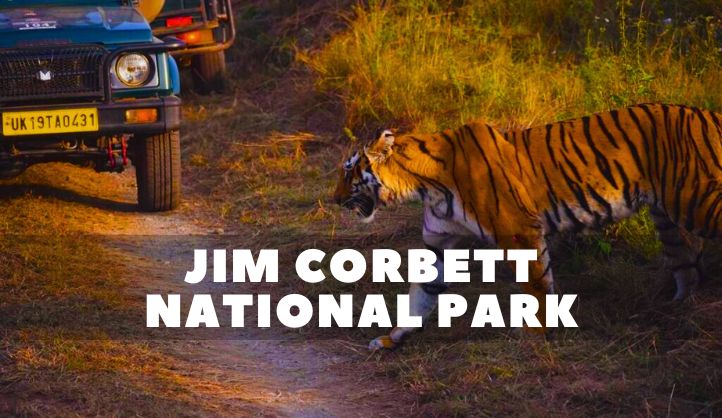Nestled in the foothills of the Himalayas, in the verdant state of Uttarakhand, lies Jim Corbett National Park, a haven for wildlife enthusiasts and nature lovers. Established in 1936, it holds the prestigious title of India’s oldest national park and is shrouded in history, teeming with biodiversity, and offering an unparalleled wilderness experience.
This captivating park was initially named Hailey National Park but was later renamed after the legendary Jim Corbett, a famed hunter-turned-conservationist who played a pivotal role in its establishment. Corbett’s dedication to protecting the Bengal tiger, India’s national animal, resonated deeply, and the park became a cornerstone in tiger conservation efforts.
A Tapestry of Landscapes
Jim Corbett National Park encompasses a diverse landscape sprawling over 500 square kilometers. Dense sal forests dominate the terrain, interwoven with grasslands, marshes, and the glistening Ramganga Reservoir. The park boasts an elevation ranging from 1300 to 4000 feet, offering a distinct change in scenery depending on the zone you visit. Winters witness crisp mornings with sunny days, while the monsoon transforms the landscape into a lush green paradise.
A Haven for Wildlife
The true magic of Jim Corbett National Park lies in its vibrant wildlife. The park is most renowned for its Bengal tiger population, boasting the highest number among all Indian national parks. Spotting a majestic tiger amidst the wilderness is a dream come true for many visitors. But the park offers a far richer tapestry of fauna. Asiatic elephants, with their gentle yet imposing presence, often grace the grasslands. Leopards, the elusive hunters, roam the denser forested areas.
Beyond the big cats, a plethora of mammals call Jim Corbett home. The barking deer, with its distinctive alarm call, and the graceful sambar deer are commonly sighted. Wild boars rummage through the undergrowth, while the shy sloth bear and the playful otters add to the diversity. Birdwatchers will be enthralled by the over 650 species of birds that flit through the canopy. From the vibrant paradise flycatcher, Himalayan monal to the majestic Himalayan griffon vulture, the park offers a haven for avian enthusiasts.
Exploring the Untamed Beauty
Exploring Jim Corbett National Park is an adventure in itself. Jeep safaris are the most popular option, allowing visitors to venture deep into the wilderness under the guidance of experienced naturalists.
Elephant safaris offer a unique perspective, enabling you to traverse the park at a leisurely pace, attuned to the sights and sounds of the jungle. Nature trails, for those seeking a more immersive experience, weave through the varied landscapes, offering a chance to witness the park’s rich flora and fauna up close.
The park is divided into several zones, each with its distinct charm. Dhikala zone, accessible only with special permits, is known for its dense forests and high tiger density. The Sonanadi zone, bordering the Ramganga Reservoir, is a haven for birdwatchers and elephant lovers. Corbett offers a unique opportunity for night stays within the park at specific zones like Dhikala. Imagine waking up to the symphony of the jungle – an experience that will stay with you forever.
Beyond the Wildlife
Jim Corbett National Park is more than just a wildlife sanctuary. It’s a place steeped in history and culture. The Corbett Museum, located in the park, sheds light on the life and conservation efforts of Jim Corbett. The nearby village of Corbett Falls, believed to be the legendary hunter’s former residence, offers a glimpse into the local way of life.
Responsible Tourism
Jim Corbett National Park is a fragile ecosystem, and responsible tourism is crucial for its preservation. Respect the park’s rules and regulations. Stay on designated trails to minimize your impact on the habitat. Avoid loud noises and maintain a safe distance from wildlife. Dispose of waste properly and leave no trace behind.
Conclusion
Jim Corbett National Park is a treasure trove of natural beauty and a testament to India’s rich biodiversity. Whether you’re a seasoned wildlife enthusiast or simply seeking a break from the ordinary, the park offers an unforgettable experience. It’s a call to the wild, an invitation to reconnect with nature, and a reminder of the importance of conservation. So, pack your bags, embrace the spirit of adventure, and embark on a journey into the heart of Jim Corbett National Park.
FAQs About Jim Corbett National Park
1. What is Jim Corbett National Park famous for?
Jim Corbett National Park is most renowned for its Bengal tiger population, boasting the highest number among all Indian national parks.
2. What are the best things to do in Jim Corbett National Park?
- Embark on a jeep safari to explore the wilderness and spot wildlife.
- Take a unique elephant safari for a different perspective of the park.
- Hike on designated nature trails for a closer look at the flora and fauna.
- Stay overnight within specific zones like Dhikala for an unforgettable jungle experience.
- Visit the Corbett Museum to learn about the park’s history and Jim Corbett’s legacy.
3. What is the best time to visit Jim Corbett National Park?
The park is open from mid-November to June. The best time to visit for wildlife viewing is generally considered to be November to mid-May when the weather is pleasant and animals are more active.
4. How to get to Jim Corbett National Park?
Jim Corbett National Park is easily accessible from major cities like Delhi, Lucknow, and Nainital by road and rail. Taxis and public transport options are readily available.
5. What are some important things to remember while visiting the park?
- Always stay in designated vehicles during safaris.
- Maintain a safe distance from wildlife and avoid disturbing them.
- Refrain from loud noises and littering within the park.
- Respect park rules and regulations for a safe and responsible visit.





